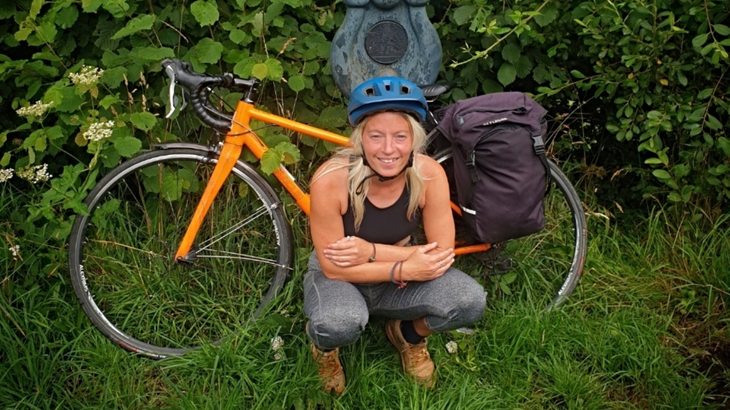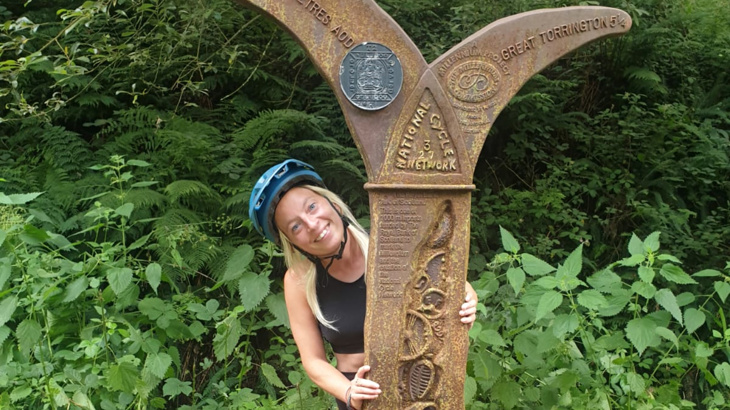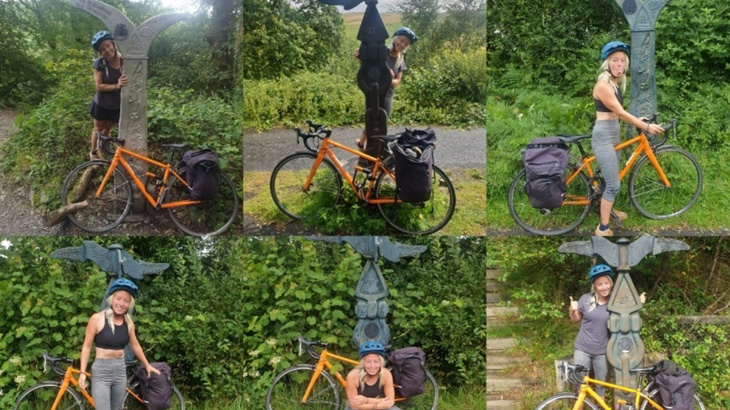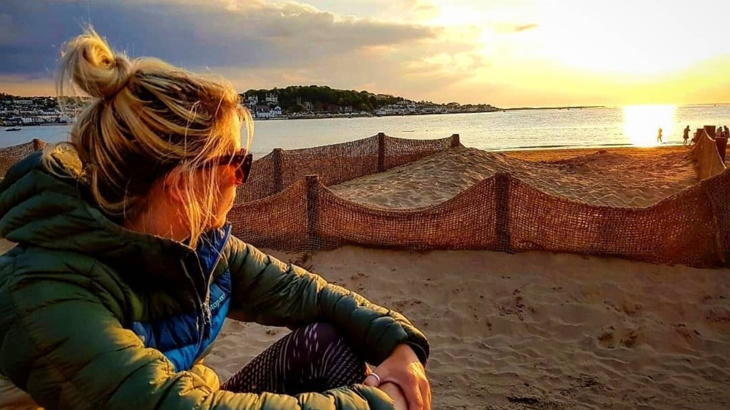As our Face-to-Face Area Manager for Devon, Ellie Lins spends a lot of time on the National Cycle Network. Outside of work hours, she likes to cycle long distances. After completing the Devon Coast to Coast route twice she shares her experience and her advice for other women embarking on long-distance cycle rides.

Regional Face-to-Face Programme Manager, Ellie talks about her experience cycling the Devon Coast to Coast route twice. Credit: Ellie Lins
If it's nice, ride it twice
Ellie has been working for Sustrans for over a decade and oversees the fundraising teams in Devon and Cornwall.
In the spring of 2021, she set out on the Devon Coast to Coast (C2C) with a group of friends and, over the course of two days, covered 100 miles of the National Cycle Network.
Not only did she complete the challenge, but she loved it so much she’s since done it again.
In this blog, she shares what she's learnt from her experiences along with her advice for other young women embarking on long-distance cycle rides.
Cycling for work and for leisure
I've cycled my whole life. And every day, especially for Sustrans, my job is to cycle somewhere.
But my hobby at the weekend is to cycle long distances.
I often plan rides where there's a train station. I'll plan where I'll get a train and how far I can cycle to another station to get a train home.
But Devon is my home, so I’ve always wanted to do it.
I wanted to cover all three of the main cycle paths in Devon in one hit: the Tarka Trail, Granite Way and Drake’s Trail.
Why the Devon Coast to Coast route?
I love cycling, and I hadn't done it - it's as simple as that.
I also work on the Tarka Trail, Granite Way and Drake’s Trail, so I wanted to cycle all three.
While it's lovely standing and chatting with people throughout the cycle routes, I wanted to know the routes even better. And to be able to talk about them properly is to do the whole thing.
I'd done all the sections, but I wanted to see all of it and give myself a bit of a challenge.
Being a parent to a 13-year-old, I don't have much free time, and I find cycling clears my head. So, a 100-mile cycle challenge was lovely and gave me some time to myself.
How did you prepare before you set off?
I made sure my bike was sound and that I had enough inner tubes, for example. A couple of people did get punctures along the way, so it was handy to have that and then also enough water and snacks.
Making sure I didn't carry too much heavy stuff was important - I had planned where to stop so that I could have some food and not need to take much with me.
As we were staying at The Youth Hostels Association (YHA), my panniers were mostly full of snacks and a couple of waterproofs, which I did need in the end!
How long did the Coast to Coast route take?
I did the first C2C ride over two days. We did about 60 miles on the first day, camped at the YHA youth hostel, and then did about 40 miles on the second day.
It was nice doing it that way, as we could stop for lots of snacks and little paddles in the rivers, and so it was more relaxed. But the 60 miles on the first day still felt quite intense.
Even though we did 60 miles on the first day, it wasn’t quite halfway, but we needed to stop at the YHA as it's the only youth hostel on the route.
As young people, we didn't really want to pay for a hotel, so I planned to get a train to Barnstable, and then there's a really cool company called TorMorSea that took me and my bike and my friends to the top and Ilfracombe.
It was spring the first time I did the challenge, and it was so sunny and lovely. Until, of course, we got to Plymouth when – classic – it absolutely cracked it down. But that's usual for Plymouth!
I think it's harder than people think unless you’ve built up some stamina.
It even tested me at some points, and I cycle quite a bit, but it was still really fun.

In the spring of 2021, Ellie set out on the Devon Coast to Coast (C2C) with a group of friends and covered 100 miles of the National Cycle Network. Credit: Ellie Lins
Soaking up nature along the way
I absolutely loved the route. It's an old train line, and so as you're cruising along, there's all the original cafes and stations to see along the way - I'm not into trains at all, but it was really cool.
And Devon's just amazing. So, passing by the rolling hills and the countryside and bluebells at that time of year was absolutely stunning.
The Granite Way is especially stunning, with the viaducts that go over Dartmoor and the beautiful Meldon Quarry.
The little villages between Okehampton and Tavistock are also beautiful and have little rivers you can swim in, which are great for cooling down.
From Tavistock to Plymouth, it's quite downhill, and you cycle through the original train tunnels, which is really cool.
As you're cruising along, there are bluebells everywhere as you come out into the Saltram National Trust woods at the bottom.
Reaching the lighthouse at the end was also a highlight.
Finishing the challenge was euphoric.
What are your top tips for cycling the C2C?
My top tip is to practise hills.
Make sure you've got enough water and take it nice and slow because you don't want to burn out.
Give yourself a lot of time, and don't pressure yourself. Just see how far you can go.
It helps to really plan your route. For example, if you think you want to get to Okehampton and then you can't, make sure you know if there's a stop halfway along so you can extend it to three days rather than two.
Don't book anything too far ahead, because you just never know if you’ll need to stop early.

Ellie took a photo next to every Millennium Milepost she passed on the Network. Credit: Ellie Lins
What advice would you give to someone looking to get into long-distance cycling?
Cycling gives you confidence. The more you do it, the more it makes you feel great.
Once the endorphins get going, it's an exercise that you don't need to be an athlete to do because a good bike does a lot of the work for you.
The things you see and the places you pass by while cycling are so amazing. It really opens up your world.
The freedom of getting out two wheels is amazing.
I think more women should cycle too.
My job is to stop and chat with people along the National Cycle Network, and I see a lot of men. It's great, but there are much fewer women.
Women seem to face more barriers. Maybe they've got too much to do, like the school run in the morning, or they're scared of the roads.
I’d recommend wrapping cycling into your day, like doing the school run on a bike.
Just make it really simple. Obviously, it’s harder if you work a lot, but if you can find that time, it becomes addictive.
I honestly think if everyone cycles one day a week to work, or just in the evening, within a month, they'll be craving two or three days a week.
Sustrans' Walking and Cycling Index (2023) found that more than twice as many men (21%) cycle more than once a week than women (10%).
The Walking and Cycling Index (formerly named Bike Life) is the biggest assessment of walking, wheeling[1] and cycling in urban areas in the UK and Ireland.
It is the clearest picture of walking, wheeling and cycling across the country.
Devon Coast to Coast route comes out on top
I’d definitely recommend this route to everybody, especially people who think they couldn't do it – because you can. You just have to break it up (for example, over two nights).
I’ve cycled from Bristol to Bournemouth, from Oxford to Swindon, and from Reading to Marlborough. I’ve also cycled from Exeter to Lands End, from Swansea to Bristol, and all around the Brecon Beacons.
But still, the Devon Coast to Coast wins by a mile as my favourite route.

"I’d definitely recommend this route to everybody, especially people who think they couldn't do it – because you can." Credit: Ellie Lins

Love the Little Red Sign
Want to find your new favourite way to explore the National Cycle Network?
Note to reader
Sustrans recognises that some people who use mobility aids, for example a wheelchair or a mobility scooter, may not identify with the term walking and may prefer to use the term wheeling. We use the terms walking and wheeling together to ensure we are as inclusive as possible.
Head to the Sustrans shop to get your waterproof, long-distance map and GPX file for this route.







